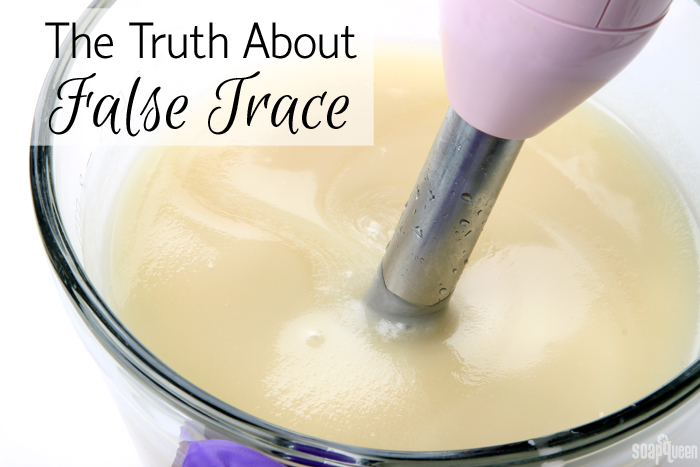 Stick blenders are an amazing tool in the soapmaking world. They can emulsify oils and lye in a minute or less, while whisks and hand mixers can take hours. Have you ever had a recipe thicken a little bit too quickly? As in, instant pudding as soon as the lye is added? Don’t toss out that stick blender! You may be dealing with “false trace.”
Stick blenders are an amazing tool in the soapmaking world. They can emulsify oils and lye in a minute or less, while whisks and hand mixers can take hours. Have you ever had a recipe thicken a little bit too quickly? As in, instant pudding as soon as the lye is added? Don’t toss out that stick blender! You may be dealing with “false trace.”
Trace is the point in soapmaking when the oils and lye have started to saponify. Once the soap reaches thin trace, it will continue to thicken as you work with it. This post has more information on trace. There are two types of false trace: fake emulsification and cool soap. This blog post deals with the cool soap type of false trace. False trace looks like the soap has saponified, as it gets quite thick. However, it is actually oils like coconut or butters like cocoa in the recipe starting to harden and resolidify before the soap is fully emulsified. Below is an example of true thick trace. False trace can look and feel like thick trace, but happens very quickly after the lye and oils are combined.
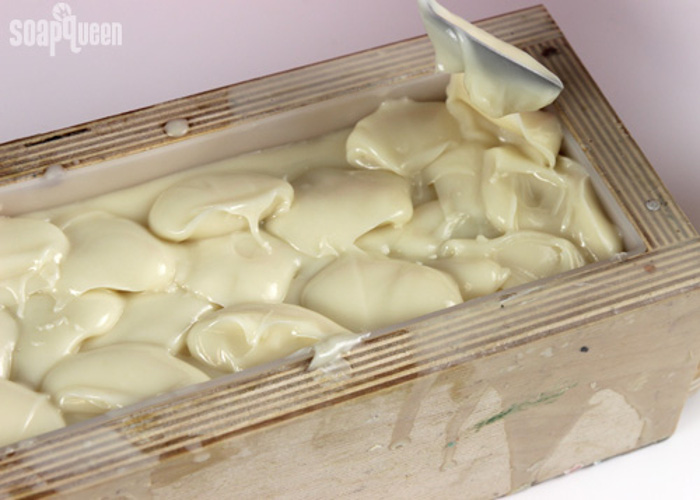 False trace looks like thick trace, but the soap hasn’t fully emulsified.
False trace looks like thick trace, but the soap hasn’t fully emulsified.
What causes false trace?
Temperature is the main cause of super thick fake false trace. When cold or room temperature lye water is poured into the soapmaking oils, it can cause them to harden up. While soft oils like avocado are always liquid, hard oils are solid up to a certain temperature. For instance, avocado butter starts to melt around 90 ° F. Cocoa butter is even higher at 100 ° F. Check out the Soaping in the Summer Heat post for more information on melting points. If adding cold lye to butters and oils that are solid at cooler temperatures, it can cause the oils/butters to cool and thicken on contact.
False trace happens pretty quickly. As the lye is poured in, the soap will start to thicken immediately. You may also notice it looks grainy. Solid chunks of soap can start to appear in the bowl. As you continue to pulse the soap, it will get thicker very quickly. Most likely, there will be chucks of thick soap along with liquid oils.
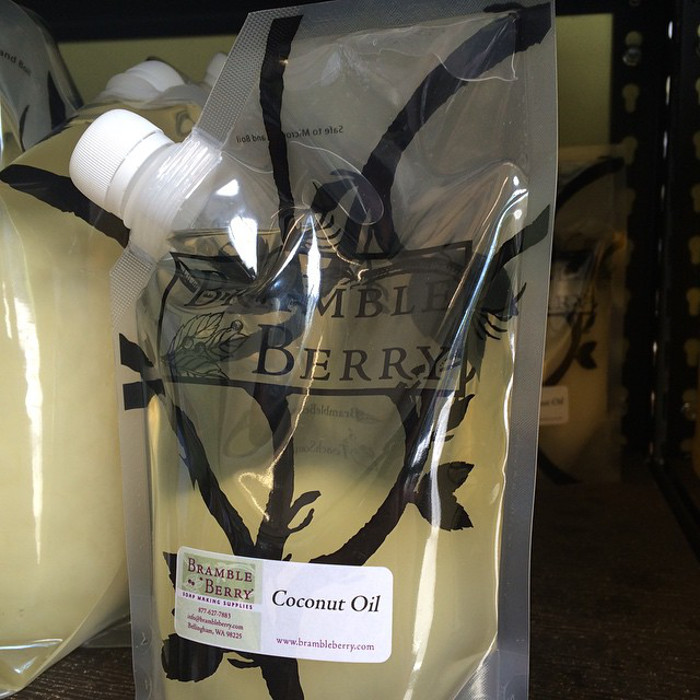 Coconut oil starts to melt at 76 ° F and is solid at cooler temperatures.
Coconut oil starts to melt at 76 ° F and is solid at cooler temperatures.
You can see false trace in the photos below. In this batch, the oils were around 100°F and the lye was around 70°F. The recipe is 25% palm oil, 30% coconut oil, 30% olive oil, 10% sweet almond oil and 5% castor oil. Below, the lye was added to the oils and the stick blender was pulsed a few times. Notice at the bottom, you can see soap that already looks emulsified.
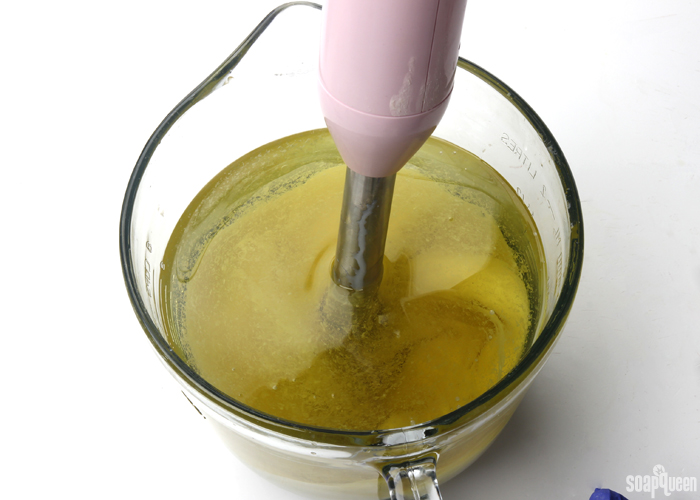
After just a few more pulses with the stick blender, check out that batter! You can see the thick chunks of soap. That is false trace. The chunks appear to be at thick trace, when they have actually cooled and hardened due to the cold lye temperature.
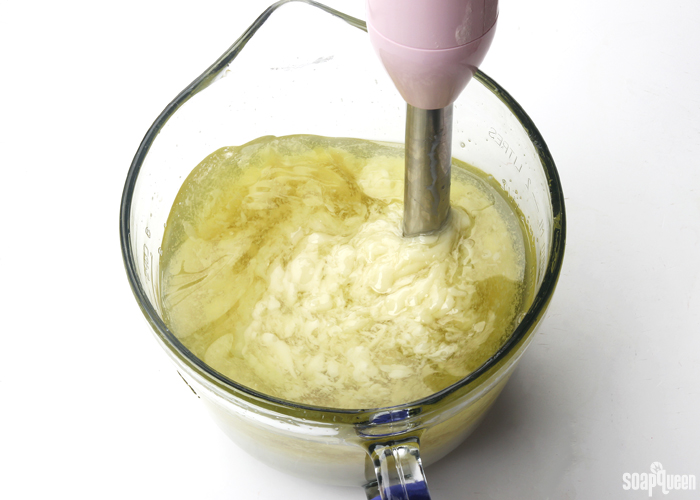 The chunks in the soap batter after just a few pulses with the stick blender is what false trace looks like.
The chunks in the soap batter after just a few pulses with the stick blender is what false trace looks like.
What do you do if your soap has false trace?
If this starts to happen to you, keep stick blending! The oils and lye need to be stick blended until the batch is emulsified. The soap will get pretty thick during this process. If you were planning on a more intricate design, you may need to switch gears. A great option for unexpectedly thick soap is the spoon plop design. See how to create that technique in the Creamy Cow Milk Cold Process Tutorial. You can also create a really simple design. While the design may not be what you planned for, it will still look great!
How to prevent false trace
Higher temperatures prevent false trace. Soaping around 100-130 ° F will keep the hard oils and butters in the batch melted throughout the entire process. False trace is common when making soap with milk if you are using a low temperature technique to prevent the milk from scalding. Certain ingredients may need higher soaping temperatures. For instance, beeswax has a melting point of 144-147°F. I recommend soaping around 170°F to keep it melted. Learn more about working with beeswax in this tutorial.
Adjusting the recipe can help as well. Adding more slow-moving soft oils like pure olive oil, canola oil, and sweet almond oil to the recipe will allow you more time to work with the design. They will stay liquid throughout the entire process and help prevent false trace. Read more about slow-moving oils in the 5 Tips for Swirling Cold Process Soap post. The Formulating Cold Process Recipes post has helpful information as well.
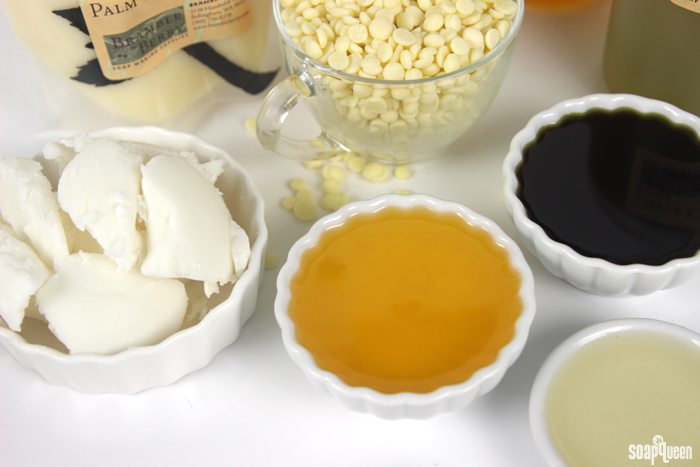 Adding more soft oils to your recipe will help prevent false trace.
Adding more soft oils to your recipe will help prevent false trace.
Have you ever experienced false trace? When it happens to your batch, keep calm and continue to stick blend. Once your soap has been cut into bars and cured, I do recommend pH testing them just to be sure the oils and lye fully emulsified. Luckily, I have found that false trace batches have turned out just fine! =)




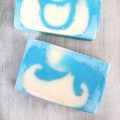
Hi I’m Tirza from Indonesia.
I’ve tried to make CP soap with this recipe :
316 gr Pomace oil
63 gr VCO
21 gr castor oil
53,5 gr lye
132 gr water
The temp here in Indonesia is around 27 degrees Celcius. I followed the recipe, weight them properly, but when I mixed the oil (104 degree F) and the lye water (99 degree F) with my stick blender, it directly form a “pudding” texture, and they were quick to harden up and were seperated one another, I couldn’t even keep blending them as you adviced.
Can you give me a solution, please?
Thankyou
When you added your lye, did it start hardening up right away? Did it look like the picture in this blog post?
So lately my CP soap has been almost like Vaseline. I melt all my oils down the night before in a crockpot. Once my oils are melted I turn off my crockpot and let it sit over night like I’ve always done. I use goats milk and freeze it so the following day I’m good to go. Well before I even added my goat’s milk to my oils which were 72° the oils were like pudding. I’ve felt with this before but this time when I added my goat’s milk and lye it started to trace immediately. I kept stick blending for a few mins then added my essential oils. This made it a little more runny. I then kept blending until it became like pudding then I poured the soap into my molds. I hope my soap will turn out okay. Is this normal? I made sure my goat’s milk and lye were the same temp as my oils too.
It sounds like you’re getting the false trace described above. That happens when the lye milk is so cool it hardens the oils in your soap before they’re fully emulsified. To prevent that, you can heat your oils up to 100-120F and let your milk sit at room temperature until it’s around 80F or so. That will give you more time to work.
“If this starts to happen to you, keep stick blending! The oils and lye need to be stick blended until the batch is emulsified.”
When I arrived ever-too-soon at a false trace today, I took this advice. Unfortunately when I did, my mixture just separated, with clear lye solution (or maybe water?) sitting at the bottom and refusing to join the party.
This is the second time this is happening to me and it seems to have happened the only two times I’ve actually used a stick blender (didn’t have one all this time).
Is it the stick blending?
Do you know why this might have happened and what I can do to avoid it next time?
Thanks.
Hmm, that’s strange. Could you tell me a little bit more about your recipe? Your soaping temperatures would also be helpful.
-Amanda with Bramble Berry
Yes, Amanda, I can tell you that I finally figured out that my recipe was very VERY lye-heavy! I would be embarrassed now to share it, but I think what happened was that I power-pulsed my soap mix into a thick fluff which was then sitting at the top of water! 🙂
Please ignore me while I slink away now 🙂
Oh no! Don’t beat yourself up too much, it has happened to us all. I’m happy that you were able to identify the problem though!
-Amanda with Bramble Berry
I love reading about the soap and find it very interesting my my herbal soap is very good thanks for advice.
You’re welcome!
-Kelsey with Bramble Berry
Hi everyone, first of all thank you for inspiring me to make soaps, and encourage in the process 😊 i tried your back to basics simple and gentle soap recipe, and was great 👌 but i divided a small portion, added mica color and vanilla fragrance …it looks and smells nice.
Second time, same recipe, temp 120°f, added tumeric and orange essential oil… It went super fast, pudding consistency, spooned it out in to silicon separate molds. After reading about lye pockets, i got so nervous that it happend to me. I can send a photo, to confirm 😩 what should i do to be sure?
I would love to try bramble berry fragrance oils, but the shipping coasts are really high for Serbia 😔 and local fragrances are (i think) not that good quality …
Absolutely, a photo would be really helpful. You can message that to us on the Bramble Berry Facebook page: https://www.facebook.com/BrambleBerry/
-Kelsey with Bramble Berry
Thank you Kelsey for the quick reply 😊
Something is happening, can’t message the photo 🤔 I’ll post it in a comment with related topic 😉
I am gleaning much from this website (((((Thanks)))))!!
So, I made soap (Yay, cheer!!). I followed a recipe similar to one of the mock/sample ones on this website. I was mindful of the oil exchanging principles plus acceptable ingredient percentages, and my soap batch emulsified in record time. In fact, I stirred it with a long-handled wooden spoon first just to get it mixed (A tip I read read somewhere recommended starting out by stirring by hand first and then switch to a blender). That was working well, honestly! Then, I used my stick blender, and it became waaaaay too thick. I had pudding, ha ha! It was evenly mixed, but it was definitely pudding! So, I spooned the mixture into my silicone mold (4-Bar style), and it did gel up, which doesn’t bother me. My main point here is my ingredients included three oils that are solid at room temperatures so I think if I keep that formula, I am going to stir with the spoon only next time. I want to be able to actually pour my soap. And, the three solid oils were palm, coconut, and shea butter. All the others were liquid oils. *Note, if I decide to try a more liquid formula, I know that I will need my stick blender!
Once again, thanks a million for creating guidance within the posts on this website. I learned a lot in advance so I could be safe and successful with soap making. In addition, I will take my subjective experience and learn from that as well. Kinesthetic learning is necessary when crafting; thus, I made notes and such on my formula pages.
I really do enjoy the creativity part of making soap! It’s fun making skin care products. Happy Soaping to all :0)
You’re welcome Heather, glad you’re enjoying soapmaking! For your next batch, I would recommend higher temperatures instead of stirring with a spoon. Stirring with a spoon may result in false trace. That happens when the hard oils solidify before they’re fully emulsified. So, while it thickens up like it should, it’s not emulsified. It usually takes at least two hours to emulsify when stirring by hand. Increasing your lye and oil temperatures to around 120-130F and stick blending for a few seconds will get everything emulsified nicely. 🙂
Learn more about false trace here: https://www.soapqueen.com/bath-and-body-tutorials/tips-and-tricks/spot-prevent-false-trace/
-Kelsey with Bramble Berry
I think I had a false trace last night while making my first batch of soap. I used a lot of cocoa butter and Shea butter and I don’t think the oils were hot enough when I mixed it and then when I put the lavender in it really got thick immediately. It did not get grainy and still stayed smooth but I had to spoon it into the molds and pressed it down with the back of the spoon to get it in. I don’t think it ever jelled but 24 hours later it looks and feels like a bar of soap and even cuts nicely. I don’t see any unevenness in the color and no holes i n the middle. Is my soap going to be safe to use after curing for 6 weeks or is it ruined. I’m scared it might never get rid of the lye. I really don’t know what I am doing and really need some help.
Hi Michelle!
As long as that soap isn’t separating it should be just fine to use! To be extra careful, I would recommend pH testing it after 5 days. Learn how to do that here: https://www.soapqueen.com/bath-and-body-tutorials/tips-and-tricks/troubleshooting-lye-heavy-soap/
As long as the soap is 9-10, it’s just fine to use on the skin. 🙂
What temperature were your lye and oils when you added them? Did the soap start to thicken as soon as the lye went in? How much of each oil were you using? Let me know and I can help you troubleshoot!
-Kelsey with Bramble Berry
I need some advise! Been making melt and pours and decided to make a batch of hot process. Wonderful….melted my coconut oil in slow cooker… added my olive oil….went and mixed my water and lye….came back and added it to the oils….didn’t have stick mixer so used hand mixer…..here’s the problem….I blended and blended and blended some more…..after about 15-20 minutes it started to thicken but not pudding but also looked grainy. Mixed another 10 minutes….thickened a bit more but not much so I just went ahead and covered it….cooked on low for 60 minutes but after the first 10 min i checked and it was raised halfway up pot and seemed like some of the oils slightly seperated…oh well we will see…another 10 min I had a mess on my counter…stirred it down and covered it….had to stir down 3 more times and the third time it stayed down but seemed lumpy….60 minutes up I put in mold….it was thick and lumpy….. top is ruff…expected that but I have no idea what happened and if it will be any good…HELP!!
Hi Kathy!
It sounds like that soap may not be fully emulsified and needs some more blending! You can use hand mixers to stir the soap, but it takes quite awhile – probably at least two hours. I would recommend mixing that soap until it looks smooth and there are no lumps. This tutorial shows you how to work with separated batches: http://www.soapqueen.com/bath-and-body-tutorials/tips-and-tricks/hot-process-hero-2/
For your next batch, I would recommend a stick blender! It emulsifies the batch fully in just a couple minutes. 🙂
Learn more about making hot process soap in this video: https://www.youtube.com/watch?v=mxTXwxbpzLM
-Kelsey with Bramble Berry
Glad I read this. Going to make my first batch of soap. May use cocoa butter. If I do, I will be sure to do 130°, thanks. I have silicone molds to do individual bars. I plan to do pour on and leave as CP. The other I will do CPOP. I want to see the difference it makes out of the same batch.
You’re welcome Miriam, glad you found the post helpful! Let us know how it turns out. I love the luxury cocoa butter adds to soap. 🙂
-Kelsey with Bramble Berry
It’s interesting that I ran across this today! Soaping at 100* with a new crisco, olive oil, coconut oil and castor oil recipe. The batch I made today had this problem. It wasn’t an extreme case, but it did get thick after the first pulse with the SB and seemed to be separating a bit with some of the liquid oil on top and some more solid bits floating around. I stopped the stick blender and set the pot into some warm water I had sitting in the sink for rinsing dishes, it just didn’t get drained after I finished them, I was doing the dishes while waiting for the lye mix to cool off. The water wasn’t supper hot, but I figured any little bit of heat would help. I used the SB to stir the mixture and the solid pieces started melting and mixing in, looking normal again. I kept the pot in the water bath and started to blend again with 2-3 pulses and then stirred for a few seconds and back to the sb and so on until it was at a thin trace. This fixed the problem completely. I had plenty of time to add my new sample FO of Apple Sage from Bramble Berry (very nice crisp clean scent by the way, thank you for that!). There was even enough time to split the batch and add some wheatgrass powder to 3/4 of the mix for an in pot swirl of green and cream! Since I only made a pound of soap for testing these went into single molds and are resting under a heated blanket to gel.
I see others recommend this trick and think it is a great thing to have around if you are testing something new or working at lower temps for milk soaps. I know I will definitely make sure I keep a sink full of hot water ready from now on, especially when I’m trying something new, making 100% coconut oil soap with coconut milk or for my raw goats milk soaps! If I don’t need it for the soap making process I’ll just use it to wash my soaping tools that don’t go in the garage to finish becoming soap, so the water isn’t wasted.
Thanks Soap Queen and all the others who make this helpful blog! You’ve been a soap saver many times over! Now I just need you to help me find some space to cure all these soaps!
**extra**space is what should have been typed in the last sentence.
Thanks for passing along this great tip Brooke! We’re definitely going to give it a try in the lab. I love simple solutions like that. 🙂
-Kelsey with Bramble Berry
I make 100% coconut oil soaps (no they are not drying 🙂 I pour it into molds at the first sign of (false) trace, which is just as you stated, just minutes after blending. I never had any separation.
I never heat up anything but keep everything cool. Years ago, when I used heat, I struggled with separation and such. Gelling also isn’t appealing to me, I didn’t notice it improve soap quality.
As an un…selfeducated soaper I need clearer explanation of the why’s of the necessity to reject first trace. Thank you for your much work
If that recipe is working out well for you, definitely stick to it! There are no set rules when it comes to soaping, and everybody’s perfect recipe is a little different. It sounds like you’ve found a great recipe that works perfectly for you. 🙂
-Kelsey with Bramble Berry
I agree that 100% coconut oil soaps are not drying if enough of a lye discount (or SF) is taken. My fishing customers especially love them because they lather in any water, where many other soaps lose theirs. They also make for a very hard long lasting bar without the need for sodium lactate or brine water. I usually soap those around 135*-140* to avoid false trace.
The problem with false trace for some is that there can be leaching of lye that didn’t get a chance to react with oils or places in the middle of the soap that are lye heavy. That causes the soap to burn the skin. Don’t ask how I know this…😬 Ha ha! Oops!
That is true! I made a soap that false traced and it had pockets of lye. It definitely helped prepare me for the next batch though! Thanks for reading Brooke. 🙂
-Kelsey with Bramble Berry
I add my lye to my oils within a 10 degree difference. This helps. plus, if doing intricate work with more then 2 colors, I use a larger amount of soft oils then hard oils.
If I am HP soaping, and my oils give a false trace, I just let it simmer for a while. It is very hard, but, I take a large spoon, break up the pieces, and mix, mix, well. Until all chunks have dispersed. It molds up fine once it becomes soap!
Having the oils and lye within 10 degrees of each other really helps! Thanks for the great tips Dianne. 🙂
-Kelsey with Bramble Berry
Had a hard time with trace acceleration. My receipe was: Canola oil 28.6%, Coconut oil 11.4%, Olive oil 28.6%, Rice bran oil 28.6%, Sweet almond oil 2.9%, Lye 4.61 oz & water 11.55 oz.
First try, I added a fragrance purchased in a Drug Store not knowing it was not quite the right place to buy it. The entire recipe became solid in a matter of seconds just mixing it manually.
Because I did not want to loose the colors I had already prepared, I decided to start over. To my surprise, this second batch was much better but became thick so rapidly that I had to change my design not able to work with such a thick mixture. I forgot to put a new fragrance in so this was not the cause. The lye was at 120 degrees and the oils at 130. I now know what the issue with the first batch but wonder why the second batch became so thick so quickly?
For the second batch, did you add the fragrance oil? If the fragrance isn’t made for soap, it can accelerate the batch. This is especially the case with fragrances that contain alcohol. Let me know and we’ll get this figured out! 🙂
-Kelsey with Bramble Berry
For the second batch, I must admit I forgot to add a new fragrance oil so there wasn’t any in that batch. Thanks for helping.
Hmm, I’m not entirely sure why that’s happening! Typically the fragrances are the culprit, so the second batch should’ve performed a bit better. Where are you getting your oils from? Thanks for answering my questions!
-Kelsey with Bramble Berry
All of my oils have been used before with success (all of them purchased in grocery stores) except for one tiny bottle of Sweet Almond Oil I had purchased a while ago in a drugstore for a skin problem. I decided to put a little bit of it in my recipe. I checked the expiry date which is 2018, and the ingredients showing : Sweet Almond Oil (prunus dulcis). The label shows: Sweet Almond Oil N.F., Skin Emolient.
Many thanks for your help with this.
Are you getting your lye from the grocery store as well? The reason I ask is sometimes lye has additives that do weird things in the batch. Also, how long are you stick blending for? Thanks Claire. 🙂
-Kelsey with Bramble Berry
i have a water heater that keeps a gallon of water at 210 degrees at all times. I use this when I get a false trace tremendously. I make my soap with 100% lard so sometimes my oil cools down too much if I have a fan running and it thickens up like shortening. But if i put the container I am working with in a bowl of very very hot water it liquifies right back up.
That’s awesome Michelle, thanks for sharing your great tip! It sounds like a really handy tool to have on hand. 🙂
-Kelsey with Bramble Berry
Thank you for the useful informations….but i have another question concerning trace. How can i prevent trace which is cuased by the addition of perfumes? Is there any special kind of perfumes for this purpose? Here in Greece, all the suppliers propose me to use lemon, pine and levanda perfumes which are alcali stable aromas. Really, it works very well but i can’t find others.
Which is the reason of this problem? What happens ? Also, i have to mention that i have used forms like this one in order to achieve high iodine and low INS in my recipes. The temperature that i use is 38-39 degrees Celsius. I have also added more water in my recipe. I have done all the efforts proposed in the internet but finally i think that i have to find special perfurmes.
Thank you a lot.
Hi Christina!
Certain fragrances can cause the soap to accelerate. This is also the case if the fragrance contains alcohol. Alcohol causes the soap to thicken really quickly. We recommend using well-behaved fragrance oils with no alcohol. They give you time to work with your design!
There are also several tricks to working with misbehaving fragrances. For instance, you can take a liquid oil from your recipe, heat it up gently and mix in the fragrance. That can help stop the initial acceleration. You can also wait to add those fragrance oils until the very end of your design. Get more tips about working with accelerating fragrance oils here: http://www.soapqueen.com/bath-and-body-tutorials/tips-and-tricks/hot-process-hero-2/
-Kelsey with Bramble Berry
Hi,
Is it an option to stop stickblending immediately when you notice false trace and put your bowl with batter in a bigger bowl with hot water, wait for a minute and then continue blending? I think it will not help when you need to raise the temperature a lot but can do some good when raising temperature a little in a small batch.
With kind regards,
Annemieke
Hi Annemieke!
We haven’t given that a try, so I’m not entirely sure! In theory the hot water may help melt the oils slightly so you have more time to work. I would recommend keeping one on hand for your next batch just in case. If you find it works well, let us know! If it’s not melting those oils back down, stick blending will help it emulsify. 🙂
-Kelsey with Bramble Berry
Great info. I don’t think I’ve ever had false trace but know sometimes I zap the stick blender 4 or 5 times and stir, and I’m already at a more than thin trace. There are no lumps or separation, just thickening soap.
Thanks Michael, glad you like the post! 🙂
-Kelsey with Bramble Berry
I’ve made a few batches of soap that I really liked, all were plain unscented and uncolored goats milk cp soap that I thought worked beautifully but upon reading this and seeing your pictures, I realize I had false trace. I mixed until it looked thoroughly mixed but it really didn’t take long at all and I poured it into molds quickly so it wouldn’t get too thick. Is there a problem with stopping at false trace? Will the soap continue to saponify as long as I leave it to cure for a long time?
If the soap isn’t fully emulsified, it can separate in the mold. When your soap is in the mold, do you notice any pockets of liquid? If so, it may have separated. If that’s the case you can use the Hot Process Hero Method to emulsify it! Read more about that method here: http://www.soapqueen.com/bath-and-body-tutorials/tips-and-tricks/hot-process-hero-2/
For your next batch if it starts to thicken up, continue to stick blend until the batch is all one color. If you see any bumps or streaks of oil, give it a couple more pulses. That will ensure it mixes nicely. 🙂
-Kelsey with Bramble Berry
I had a batch with false trace, but it looked normal. It was only as it was in the mold that it started to separate, and oil started oozing out of the corners – yikes! I tossed it back into the pan, turned the burner on low and guessed at how much oil I had lost. I got it back to a liquid/trace stage, poured it back into a mold.. and prayed. It set up fine, but it WAS NOT Pretty! I let it cure and did a PH test on it. Don’t worry, I did not try to sell it, I used it. It came out fine.
I researched a little bit on line, but I was running out of time, so I went with my gut and did what I did. Not sure if this was correct, but it worked. I LOVE the fragrance, so I’m tempted to try it again, now knowing what to expect.
That’s awesome, I’m glad you were able to save that batch! For separation we usually recommend heat to help it emulsify, so you did just the right thing.
For your next batch, having your oils and lye around 100F can help prevent false trace. A few more pulses with the stick blender can help as well! Blend until the mixture is smooth and you don’t see any streaks of oil. 🙂
-Kelsey with Bramble Berry
Very interesting and helpful post on false trace! Thank you for this info 🙂
You’re welcome Linda! Glad you found it helpful. 🙂
-Kelsey with Bramble Berry